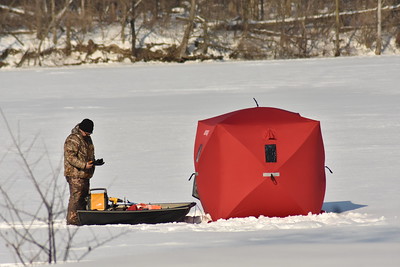
 I Speak for the Fish is a new monthly column written by Great Lakes Now Contributor Kathy Johnson, coming out the third Monday of each month. Publishing the author’s views and assertions does not represent endorsement by Great Lakes Now or Detroit Public Television. Check out her previous columns.
I Speak for the Fish is a new monthly column written by Great Lakes Now Contributor Kathy Johnson, coming out the third Monday of each month. Publishing the author’s views and assertions does not represent endorsement by Great Lakes Now or Detroit Public Television. Check out her previous columns.
There had to have been at least three dozen rainbow trout surrounding me. My heart thumped loudly as adrenaline flooded my veins. The mass of fish tightened around me until I lost sight of the camera in front of me and the sunny surface above.
Iridescent bodies circled my head and zipped around so fast I only saw streaks of silver, pink and blue. I’d intentionally incited a feeding frenzy with myself at the center of a tornado of rainbow trout.
And it was awesome!
Their metallic bodies had a pastel shimmer like a rainbow reflecting off the hood of a chrome racecar.
The water was cloudy with fish food, and the frenzied fish were biting my hooded head, buoyancy compensator and gloved hands. One targeted the 2-inch strip of exposed skin between my mask and hood.
The bite was sharp without breaking the skin, like a hard pinch from an annoyed sibling. Rather than leave, I simply covered my cheeks with my hands so I could continue to experience a fish feeding frenzy from the inside.
For almost 100 years, from the 1890s through the early 1980s, millions of tons of dolomite – a type of limestone – were extracted from the ground in northern Ohio, creating a 14-acre quarry pit. When the quarry was operating, giant pumps kept the pit from flooding. As soon as the quarry closed, the pumps were shut down and the pit filled up.
A natural spring continually feeds the quarry with icy-cold water of 41 degrees Fahrenheit. That ensures the temperature on the bottom never rises above the low 40s. It’s warmer near the surface in the summer, but not by much.
Northwestern Ohio might seem like an unlikely place to find a busy dive destination, but divers of all skill levels have been visiting the site since Mike Williams opened it to divers in 1990.
Most divers came to Gilboa Quarry to see their collection of sunken attractions. And I’ll admit it’s not every day that one can swim through the hull of a Grumman airplane, sit in the cockpit of a Sikorsky helicopter, ride a motorcycle and glide down the aisle of a yellow school bus on the same dive.
The popular dive destination features a shop with a tank-filling station, a campground with hot showers, easy entry docks, a swimming beach and expansive parking.
The quarry is a favorite destination for Midwest dive instructors teaching everything from entry level classes to underwater navigation and night diving courses.

At Gilboa Quarry, divers can swim through the hull of a Grumman airplane, sit in the cockpit of a Sikorsky helicopter, ride a motorcycle and glide down the aisle of a yellow school bus on the same dive. (Photo Credit: Greg Lashbrook/PolkaDot Perch)
Several wooden platforms have been installed at 10, 15 and 60 feet as secure places for underwater instruction and practicing new skills like flooding a mask. The platforms also keep the divers from disturbing the bottom, which helps maintain an average visibility of about 40 feet.
The underwater attractions are located on the quarry’s shallow side, making them accessible to all levels of divers. With a maximum depth of 137 feet, the quarry is used by law enforcement agencies for training exercises. And it’s not uncommon to meet groups of highly skilled technical divers as they frequently use the quarry to test new gear or practice deep-water skills.
In addition to a motorcycle, two cars, a van, a truck, a school bus, a small motorboat, a helicopter and a small plane as sport diving attractions, Williams also stocked the quarry with a variety of fish species including bass, catfish, sunfish, trout and some gorgeous koi.
The quarry’s largest resident is a 7-foot paddlefish.
After registering, signing multiple waivers and receiving a quick briefing on the quarry, I headed for the check-out counter. While standing in line, I noticed they were selling a sandwich-sized zip-top plastic bag labelled ‘fish food’ for $2. I purchased one. The bag contained about a cup’s worth of hard, dark brown pellets. They reminded me of rabbit feed.
The fish food came with a verbal warning.
The fish could get “kinda aggressive.” If I was uncertain or uncomfortable with having fish get right in my face, the clerk said I might want to pass on the food. The worry in her eyes gave me pause, for a millisecond.
I told her to ring me up.

At Gilboa Quarry, you can purchase feed for the fish. (Photo Credit: Greg Lashbrook/PolkaDot Perch)
While suiting up, my husband Greg and I chatted with another group of divers. They said the trout hang out at the school bus, so that was the best place for feeding. I tucked the bag of food into my pocket before stepping down the large, submerged ladder perfectly designed to easily accommodate a diver’s fins.
A guideline ran from one attraction to the next, ensuring we didn’t miss any or get lost. It was the first time I’d followed an underwater trail, and while I expected it to be kind of lame, it was actually kind of fun.
The motorcycle was mounted on a wooden platform so divers could easily sit on it. Having one’s picture taken astride the bike was a Gilboa rite of passage for many.
We passed all the automobiles without stopping. Greg and I had both seen plenty of vehicles underwater as members of the Sherriff dive team, so we barely gave them a glance as we swam past.
The plane’s doors had been removed to give divers easy access to the cargo hold area. As we swam through the plane’s interior, we disturbed a large catfish resting behind the captain’s seat.
The plane was bigger, but the helicopter was cooler.
Sitting in the pilot’s seat, I enjoyed a surreal moment as a school of sunfish swam past the domed glass. It seemed oddly appropriate that my first time in a helicopter was underwater. But we did not linger for long.
I was anxious to get to the bus – or rather, the trout.
The faint yellow glow in the distance was unmistakable. All the attractions were interesting, but seeing an actual school bus sitting on the bottom as if ready to drive off at any moment solidified this as world-class underwater theme park.
I knelt on the yellow bus roof and looked around. Half a dozen rainbow trout were circling 10 feet overhead. As soon as I pulled the plastic bag out of my pocket, they dropped down directly in front of me.
I stretched my arms away from my chest and gingerly opened the bag. I did not expect the pellets to be so buoyant. Half the bag floated away before I could pinch off the opening. The trout zipped in and quickly gobbled up every nugget.
I opened the bag and released the remaining pellets. The trout dashed around, and in less than 60 seconds they devoured the entire bag of food.
Back at the dock, Greg swapped out tanks while I ran down to the shop in my wetsuit. When I slapped a $20 bill on the counter and asked for ten bags of food, the stunned clerk took one look at my dripping wet hair, shook her head and rang me up.
The trout were conditioned to one or two divers in each group offering a single bag. When I released four bags at the same time, the sheer volume of food in the water caused them to go a little crazy or frenzied.
It was the best kind of theme park experience, thrilling and scary without any actual risk.
I never expected that one of my favorite fishy dives would be in an Ohio quarry. But Gilboa is an underwater theme park with such a variety of attractions that any level of diver in the world would enjoy visiting.
So, while others flock to Cedar Point, Gilboa is my summer theme park of choice.
Author’s note: This column marks the one year anniversary of I Speak for the Fish! My sincerest thank you to everyone for reading, liking, commenting and sharing over the past year. The most popular column was inspired by a reader’s request, so please let me know if there is a Great Lakes species or topic that you’d like to learn more about, and I’ll see what I can do. Leave a comment below or email Great Lakes Now at greatlakesnow@dptv.org.
Catch more news at Great Lakes Now:
I Speak for the Fish: How the round goby changed the Great Lakes, twice
I Speak for the Fish: Playing peek-a-boo with the ducks
Featured image: At Gilboa Quarry, you can purchase feed for the fish. (Photo Credit: Greg Lashbrook/PolkaDot Perch)
5 Comments
-
I drive down from MI to dive this quarry and try to never miss feeding the trout. You are right- it’s so much fun. Was just there last weekend. Not a lot of people diving yet. The fish followed us for quite some time!
-
@ Lydialfm awesome for you! I probably won’t get there until July or August!! Thanks for sharing.
-
-
Everything you say about Gilboa quarry is correct. It’s a great experience for divers of all skill levels. In my opinion, the fish are the best part!
-
@ Eric thanks for sharing and taking the time to comment!
-
You might check that water temp again. I have springs flowing artesian that flow several thousand gpm at 51 degrees. My water comes from several hundred feet deep.




